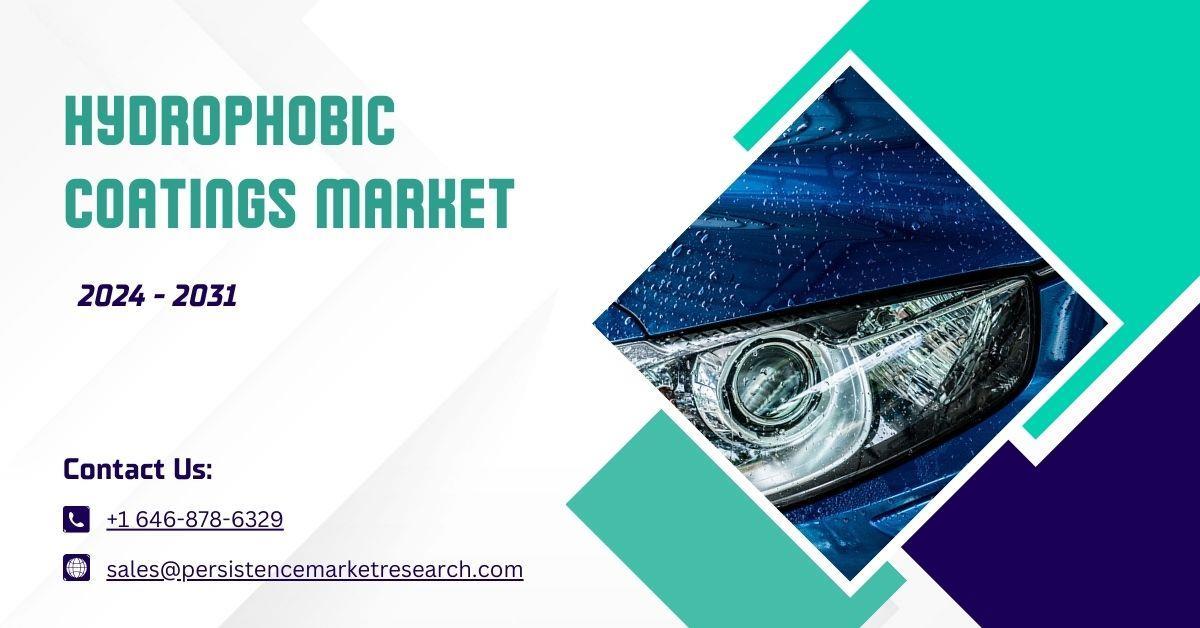How are hydrophobic coatings used in these industries?

Hydrophobic coatings have become indispensable in various industries due to their ability to repel water and prevent its adhesion to surfaces. These coatings create a protective layer that causes water and contaminants to roll off, ensuring that surfaces remain clean and dry. The adaptability of hydrophobic coatings makes them valuable across multiple sectors. This article explores how these coatings are used in key industries, highlighting their benefits and specific applications.
For More Industry Insight: https://www.persistencemarketresearch.com/marketresearch/hydrophobic-coating-market.asp
1. Automotive Industry
In the automotive industry, hydrophobic coatings are employed to enhance the durability, appearance, and functionality of vehicles. Their applications span several components:
• Exterior Surfaces: Hydrophobic coatings are applied to vehicle exteriors, including paintwork and body panels. These coatings create a protective barrier that repels water, reducing the accumulation of dirt, road grime, and other contaminants. This not only helps in maintaining the vehicle’s aesthetic appeal but also prolongs the life of the paint by minimizing damage from environmental factors.
• Windshields and Windows: One of the most significant uses of hydrophobic coatings in the automotive sector is on windshields and windows. The coatings improve visibility by causing water to bead up and roll off more quickly. This is especially useful during rainy conditions, as it reduces the reliance on windshield wipers and enhances driver safety. The coatings also help in preventing the buildup of grime and debris on the glass.
• Interior Components: Hydrophobic coatings are also used on various interior surfaces, such as upholstery and dashboards. These coatings repel spills and stains, making it easier to clean and maintain the vehicle’s interior. This application helps to keep the
interior looking new and extends the lifespan of materials by protecting them from moisture and other contaminants.
2. Electronics Industry
The electronics industry benefits significantly from hydrophobic coatings, which protect sensitive electronic components from moisture and dust. Key applications include:
• Circuit Boards: Hydrophobic coatings are applied to circuit boards to safeguard them from moisture, which can cause short circuits and corrosion. The coatings create a barrier that repels water, ensuring the reliable operation of electronic devices. This is particularly important for electronics used in harsh environments where exposure to moisture is likely.
• Displays and Touchscreens: In consumer electronics, such as smartphones and tablets, hydrophobic coatings are used on displays and touchscreens. These coatings not only repel water but also reduce smudging and improve the overall cleanliness of the screen. By minimizing water spots and fingerprints, the coatings enhance the user experience and maintain the device’s appearance.
• Connectors and Cables: Hydrophobic coatings are applied to connectors and cables to protect them from moisture and environmental damage. This application ensures that electronic devices maintain optimal performance and longevity, especially in outdoor or industrial settings where exposure to moisture is common.
3. Healthcare Industry
In the healthcare industry, hydrophobic coatings are crucial for maintaining hygiene and enhancing the performance of medical devices. Their applications include:
• Medical Devices: Hydrophobic coatings are used on various medical devices, such as catheters, surgical instruments, and implants. These coatings prevent the accumulation of moisture and biological contaminants, reducing the risk of infections and improving the safety and efficacy of medical procedures. The coatings also facilitate easier cleaning and sterilization of medical equipment.
• Protective Coatings for Equipment: Medical equipment that operates in high-humidity environments benefits from hydrophobic coatings. These coatings protect sensitive components from moisture-related damage, ensuring the reliable operation of devices such as diagnostic machines and monitoring equipment.
• Antimicrobial Properties: Some hydrophobic coatings used in healthcare are combined with antimicrobial agents. This combination helps to reduce the growth of bacteria and other pathogens on surfaces, further enhancing hygiene and safety in medical environments.
4. Textile Industry
In the textile industry, hydrophobic coatings are applied to fabrics to enhance their functionality and performance. Major applications include:
• Outdoor Apparel: Hydrophobic coatings are used on outdoor apparel, such as jackets and hiking gear, to make them water-resistant. These coatings repel water, preventing it from soaking into the fabric and keeping the wearer dry in adverse weather conditions.
This application is particularly valuable for performance wear designed for outdoor activities.
• Home Textiles: Hydrophobic coatings are also applied to home textiles, including upholstery, carpets, and curtains. These coatings protect fabrics from spills, stains, and moisture, making them easier to clean and maintain. By repelling water and contaminants, the coatings help to extend the lifespan of home textiles.
• Industrial Fabrics: In industrial settings, hydrophobic coatings are applied to fabrics used in applications such as protective clothing and machinery covers. These coatings help to repel water and other substances, ensuring that the fabrics remain functional and durable in challenging environments.
5. Construction Industry
The construction industry benefits from hydrophobic coatings in various ways, primarily through their application on building materials and surfaces:
• Facade Protection: Hydrophobic coatings are used on building facades to protect against water damage and weathering. The coatings repel rainwater and prevent it from penetrating the building’s exterior, reducing the risk of structural damage and deterioration.
• Roofing Materials: Hydrophobic coatings are applied to roofing materials to enhance their water resistance and longevity. These coatings prevent water from infiltrating the roof, thereby reducing the risk of leaks and extending the lifespan of roofing systems.
• Concrete and Masonry: In construction, hydrophobic coatings are used on concrete and masonry surfaces to prevent water absorption and damage. The coatings help to protect these surfaces from moisture-related issues, such as efflorescence and corrosion, ensuring their durability and performance.
